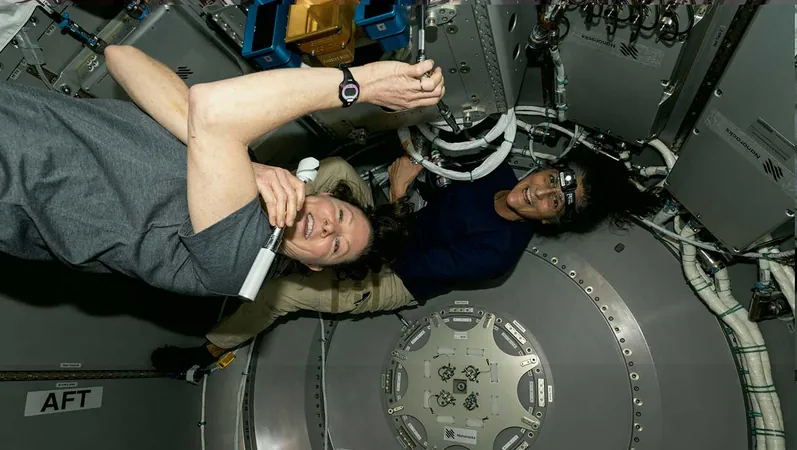
Revolutionary Earth Observation Technology Launches from the ISS: Unlocking New Frontiers in Climate Research and Disaster Monitoring!
2024-09-25
Introduction
CAPE CANAVERAL, FL – September 25, 2024 – The International Space Station (ISS) is set to revolutionize environmental monitoring with groundbreaking technology that promises to deepen our understanding of climate change and natural disasters. Thanks to a pioneering initiative led by Airbus U.S. Space and Defense, Inc., and supported by the ISS National Laboratory®, unprecedented access to Earth observation capabilities is about to take flight.
Airbus's ArgUS Platform
Debra Facktor, head of U.S. Space Systems at Airbus, expressed excitement about the new developments, emphasizing, “We are not only enhancing our ability to observe Earth but also democratizing access to space. The ArgUS platform on the Bartolomeo module will support smaller payloads with robust data processing capabilities previously reserved for larger projects.”
The Bartolomeo platform, situated in the European Columbus Module, is designed to provide all-encompassing mission services, facilitating a variety of research endeavors from Earth observation to astrophysics. Its innovative ArgUS Multi-Payload Adapter can accommodate multiple smaller payloads, allowing diverse experiments to be conducted side by side in an efficient and cost-effective manner.
Technology Demonstrations
This week's operations will kick off with exciting technology demonstrations, including Sen's remarkable SpaceTV-1, a cutting-edge 4K camera system. This system will stream real-time, high-definition video from the ISS, offering dual perspectives of Earth—one aimed at the horizon and another positioned directly downward. Viewers worldwide will have access to this stunning footage via the Sen app, potentially fostering a greater appreciation for our planet's beauty and fragility.
“By providing timely imagery, we hope to deliver critical insights into environmental events and actively collaborate with agencies that can utilize our data to aid those affected,” stated Charles Black, CEO of Sen. “Highlighting the majesty of our planet has the remarkable potential to inspire global change.”
BAE Systems' Innovations
In addition to imaging efforts, BAE Systems is set to test innovative hardware and software solutions for advanced Earth observation and weather tracking. The findings from these tests could provide vital information on climate change and natural disaster threats, ultimately benefiting future missions to the Moon and beyond.
The hardware from BAE Systems features a next-generation radio frequency receiver for atmospheric sounding and a short-wavelength infrared camera, showcasing cost-effective monitoring technologies. Additionally, BAE's Linux-based software aims to demonstrate enhanced data processing capabilities in orbit, offering a clearer vision of our changing planet.
Looking Ahead
Steve Smith, vice president of BAE Systems Space & Mission Systems, remarked, “Our objective is to expedite advancements in Earth observation and data processing technologies, demonstrating our capacity for rapid development at lower costs. These demonstrations are poised to advance the field of environmental monitoring significantly.”
With the introduction of ArgUS, researchers and institutions can now access low Earth orbit more affordably than ever before, shattering previous barriers to entry. The platform ensures that data can be downloaded quickly and easily, enabling scientists to obtain vital information in a timely manner.
Mission Overview
The ArgUS payload made its debut on SpaceX's 30th Commercial Resupply Services mission, which was contracted by NASA and included over 40 research payloads sponsored by the ISS National Lab. This mission showcases not only the collaborative spirit of space research but also the commitment to addressing the pressing challenges faced by our planet.
Conclusion
Stay tuned as we follow the developments from the ISS that hold the potential to transform our understanding of Earth and its environment. Who knows? The next big breakthrough in climate science could be just around the corner!


 Brasil (PT)
Brasil (PT)
 Canada (EN)
Canada (EN)
 Chile (ES)
Chile (ES)
 España (ES)
España (ES)
 France (FR)
France (FR)
 Hong Kong (EN)
Hong Kong (EN)
 Italia (IT)
Italia (IT)
 日本 (JA)
日本 (JA)
 Magyarország (HU)
Magyarország (HU)
 Norge (NO)
Norge (NO)
 Polska (PL)
Polska (PL)
 Schweiz (DE)
Schweiz (DE)
 Singapore (EN)
Singapore (EN)
 Sverige (SV)
Sverige (SV)
 Suomi (FI)
Suomi (FI)
 Türkiye (TR)
Türkiye (TR)